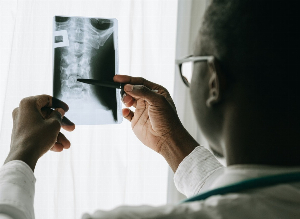Ankylosing spondylitis: What are flare-ups and how to manage them?
Published 10 Feb 2022 • By Courtney Johnson
Ankylosing spondylitis, or AS, is an auto-immune disease affecting the spine, hips, or lower back joints. Like many inflammatory conditions, AS is punctuated by periods of worsening symptoms, or flare-ups.
What is an ankylosing spondylitis flare-up exactly? What are the symptoms and causes? How can you cope better with them?
We answer these questions and more below!

What is ankylosing spondylitis (AS)? What is a flare-up?
Ankylosing spondylitis (AS) is a form of auto-immune arthritis which typically affects the spine, hips, or sacroiliac joints (which connect the spine to the pelvis), but also the knees, ankles, neck, or entheses (connective tissues where ligaments and tendons attach to bone). This condition causes inflammation of the affected areas, triggering pain, stiffness, and swelling, among other symptoms.
As with other types of inflammatory disease, ankylosing spondylitis is also characterised by periods of worsening symptoms, or flare-ups, and periods of fewer, milder, or no symptoms, or remission.
While people living with AS often have chronic hip, pelvic, and lower back pain that comes and goes, during a flare-up this pain becomes significantly stronger and debilitating. During a flare, the patient may need more treatments or care than they would in a remission period.
Research has indicated that AS flares are common: a 2017 study published in the Journal of Rheumatology found that patients experience on average one flare-up per month lasting around 2 weeks, while a 2010 study in the journal Rheumatology by the British Society for Rheumatology observed that 70% of AS patients experience a flare in any given week.
What are the different types of AS flares? What are the symptoms?
While ankylosing spondylitis flares tend to vary per patient, researchers have been able to identify two main types:
- Localised flare-ups: When symptoms affect one main area, causing pain, fatigue, and immobility.
- Generalised flare-ups: When symptoms are more severe and affect multiple areas of the body. Patients often experience flu-like illness (fever, sweating, etc.), muscle spasms, burning joints, increased sensitivity, in addition to symptoms experienced during a localised flare.
Patients typically report the following symptoms during an AS flare:
- Pain in the hips, lower back, and buttocks: Pain may develop gradually over a few weeks or months, with discomfort on one side or alternating sides. This is typically a dull pain that is worse first thing in the morning upon waking.
- Fatigue: Enduring inflammation and pain can also provoke intense fatigue and tiredness, which may be worsened by poor sleep at night due to discomfort and pain.
- Stiffness: Pain in the hips, lower back, and buttocks may be accompanied by stiffness, making it difficult to stand, particularly in the morning and at night. It may worsen after a period of inactivity.
- Pain and stiffness in other joints: While pain is often focused on the lower back area, it can also affect other joints during a flare-up. Enthesitis (inflammation of the insertion of the tendon onto the bone) in the ankle or knee joints, costochondritis (inflammation of the cartilage connecting the ribs to the sternum), and neck pain are also common.
- Fever: Fever can be a sign of an AS flare, but it is still important to inform your doctor if you experience one, as it could be a sign of another health issue, notably infection. Patients taking biologics, a common treatment regimen for AS, are at higher risk of infection, so it is important to contact your doctor if you experience fever or another symptom of infection such as sweats, chills, or weight loss.
- Eye problems: The Spondylitis Association of America reports that up to 40% of people living with spondylitis – an umbrella term for a group of inflammatory disease including AS, psoriatic arthritis, and others – experience eye inflammation, called iritis or uveitis. This inflammation causes pain, redness, blurry vision, sensitivity to light, or floaters in one or both eyes.
- Depression: Chronic pain can be mentally, as well as physically draining. Studies have shown that up to 75% of ankylosing spondylitis patients experience emotional symptoms such as depression during a flare-up.
What causes AS flare-ups?
Unfortunately, there are still no known causes for ankylosing spondylitis and its flare-ups, which cannot always be prevented or controlled.
Some flares may appear to follow infections, high-stress situations, change in weather, or over-exertion. Many patients are able to identify their flare triggers with time, which helps them to prevent them or develop a management plan
How are AS flares treated?
Medicinal treatments
The first-line treatment option for ankylosing spondylitis flare-ups includes NSAIDs such as ibuprofen (Nurofen®, Calprofen®), aspirin (Nu-Seals®), or naproxen (Stirlescent®), which help to relieve inflammation.
Corticosteroid medications such as prednisone, a potent anti-inflammatory drug, can also be prescribed in the case of severe flares that do not respond to more conservative treatments. These can be administered by injection for a stronger and faster action.
For AS flare-ups that are progressing in severity, are longer lasting, or are occurring more frequently, biologics, a type of disease-modifying antirheumatic drug (DMARD), may be prescribed. These drugs, in addition to relieving AS symptoms, help to block the inflammatory process in the body before it even starts.
In the UK, there are currently 7 biologics approved for treating AS:
5 TNF-alpha inhibitors:
- Adalimumab (Humira®)
- Certolizumab pegol (Cimzia®)
- Etanercept (Enbrel®, Benepali®, Erelzi®)
- Infliximab (Remicade®), or biosimilars Inflectra® (infliximab-dyyb), Flixabi® (infliximab-abda), and Remsima®
- Golimumab (Simponi®)
And 2 IL-17 inhibitors:
The UK is also also set to approve 1 Janus kinase (JAK) inhibitor by June 2022. This medicines has already been approved by the FDA in the US and the European Medicines Agency for ankylosing spondylitis in late 2021:
- Tofacitinib (Xeljanz®)
Finally, methotrexate, another DMARD and a common chemotherapy drug, may also be prescribed, orally or by injection.
>> Learn more about methotrexate in our article here! <<
Gentle exercise
With ankylosing spondylitis, pain is often more severe after periods of inactivity and improves with movement. It is therefore important to keep yourself moving, through adapted exercises and in moderation. Modified yoga, tai chi, walking, the elliptical machine, swimming, range-of-motion exercises, or even just deep stretching or breathing are all exercises that can benefit AS patients.
Finding a balance between gentle exercise and rest can be a great tool in managing a flare.
Transcutaneous electrical nerve stimulation (TENS)
Though it may have an intimidating name, TENS can be a helpful adjunct therapy to help manage pain. A TENS device, which can be prescribed by a physical therapist, regulates pain response by blocking the nerve signals to the brain.
Though it hasn’t been empirically proven to be effective, many patients find benefit and it is safe to use once you’ve been properly instructed on how to use it.
Hot or cold therapy
While there isn’t much scientific evidence about the impact of heat or ice, many patients find that using a heating pad or taking a warm bath or shower in the morning can ease pain and stiffness. In the same way, applying a cold pack on inflamed areas can help to reduce inflammation.
How to cope during an AS flare-up?
Here are a few tips that may help you to cope when faced with an AS flare:
Be prepared for a flare
When it comes to AS flares, a little bit of prevention can go a long way. Though there is no way to fully stop a flare, there are steps that can be taken to better manage them. Stretching, strength training, better posture, and endurance exercises for heart health can all help you to better face a flare.
Doctors recommend doing activities or exercises that promote spinal extension and rotation and work on knee and hip strength and incorporating them into your daily life. For example, while at work, try to take regular breaks from sitting at your desk, opt for a standing desk, or try to lie down on your stomach while propped on your elbows while playing with your kids or grandkids instead of sitting on the floor.
Find the pain and stress management techniques that work for you
In addition to medicinal options for pain relief, many mind-body techniques like meditation, mindfulness, or deep breathing can help to ease or take your mind off the pain. Focusing on areas of the body that aren’t in pain and integrating breathing exercises into your routine can help reduce the anxiety you may feel because of your discomfort.
Also, don’t forget to check in on your mental health! Chronic pain can be a challenge for both the body and mind. Many patients find benefit in talking with a therapist or other mental health professional who understands chronic pain, or joining support groups like Carenity’s ankylosing spondylosis forum where they can share with others who understand.
Make time for rest
Though it can be hard when you have a busy schedule, it’s important to know your limits and when it’s time for you stop. Try to incorporate time for rest into your daily routine, and if you sense a flare may be coming, don’t hesitate to take a break or ask for help from family or friends.
Was this article helpful to you?
Give it a like and share your thoughts and questions with the community in the comments below!
Take care!

 Facebook
Facebook Twitter
Twitter


